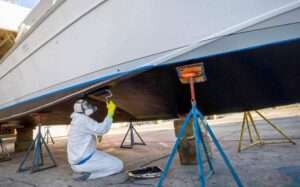Nautical Flags: Understanding the Language of the Seas
Ever wondered what those colorful flags on boats mean? Well, they’re not just decorations! Nautical flags are a vital way for boaters to communicate with each other and with authorities.
This guide will teach you the basics of nautical flags, including:
- The Flag Alphabet: Did you know there’s a whole flag code? We’ll break down the 26 flags, each representing a letter, to get you started.
- Color Coordination: Spotting a nautical flag is easy thanks to the limited color palette of blue, yellow, white, black, and red.
- Weather Warnings: Stay informed on the water with the four weather flags that use red and/or black to signal everything from small craft warnings to hurricanes.
- Decoding Flag Signals: The number of flags flown together holds meaning too! We’ll explore what one, two, three, and more flags signify.
- International Flag Meanings: Each letter flag has a specific meaning beyond just the alphabet. Learn what “Alpha” (A) means (divers below!) and other important messages.
By understanding nautical flags, you’ll be better equipped to navigate the seas safely and be part of the maritime communication network.
SIGNALS BROKEN DOWN BY NUMBER OF FLAGS
The number of flags present has a meaning. Here’s the breakdown
- One-Flag Signals – Urgent or Common
- Two-flag Signals – Distress or Maneuvering
- Three-Flag Signals – Points of the Compass, Standard-Times, Verbs, Punctuation, Code and Decode Signals
- Four-Flag Signals – Geographic, Names of Ships, and Bearings
- Five-Flag Signals – To Relate Position and Time
- Six-Flag Signals – Indicate West, East, South, or North in Longitude or Latitude Signals
- Seven-Flag Signals – Longitude with more than one-hundred degrees
- Nautical flags are also used in racing to communicate messages to competitors.
INTERNATIONAL NAUTICAL FLAG MEANINGS
Each flag representing a letter of the alphabet has a meaning. The meanings are as follows:
- A or Alpha – keep clear, diver down
- B or Bravo – carrying dangerous cargo
- C or Charlie – yes
- D or Delta – keep clear
- E or Echo – altering course to starboard
- F or Foxtrot – I am disabled
- G or Golf – I want a pilot
- H or Hotel – a pilot on board
- I or India – altering course to port
- J or Juliet – vessel on fire, keep clear
- K or Kilo – I want to communicate with you
- L or Lima – stop your vessel instantly
- M or Mike – my vessel is stopped
- N or November – no
- O or Oscar – man overboard
- P or Papa – vessel is about to sail
- Q or Quebec – I request free pratique
- R or Romeo – reverse course
- S or Sierra – engines are going astern
- T or Tango – keep clear
- U or Uniform – you are heading into danger
- V or Victor – require assistance
- W or Whiskey – require medical assistance
- X or X-ray – stop your intention
- Y or Yankee – I am dragging anchor
- Z or Zulu – I require a tug
- Understanding the meaning of nautical flags can help you communicate and receive messages on the water.
Spread the love



